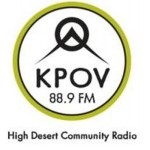 In case you missed this interview when it aired live on KPOV in Bend, you can catch it here. Thanks, Pearl, for having me on the show. It was such a pleasure to talk about THE WAY BACK FROM BROKEN and THE V-WORD!
In case you missed this interview when it aired live on KPOV in Bend, you can catch it here. Thanks, Pearl, for having me on the show. It was such a pleasure to talk about THE WAY BACK FROM BROKEN and THE V-WORD!
 In case you missed this interview when it aired live on KPOV in Bend, you can catch it here. Thanks, Pearl, for having me on the show. It was such a pleasure to talk about THE WAY BACK FROM BROKEN and THE V-WORD!
In case you missed this interview when it aired live on KPOV in Bend, you can catch it here. Thanks, Pearl, for having me on the show. It was such a pleasure to talk about THE WAY BACK FROM BROKEN and THE V-WORD!
The holidays are over. The new year has begun. We’re all back at work… whew… if you need a little break from the madness of “real life,” you can listen to me talk about THE WAY BACK FROM BROKEN with Kathleen Stephenson on Between the Covers at KBOO radio.
Click here!
I really hope I don’t sound like a dork! XO
THE WAY BACK FROM BROKEN got a really nice review from VOYA. One section really resonated with me:
“A valuable theme in the book is how relationships can lead us back from broken. The shared experiences and honest discussion of their emotions are what are able to help Rakmen, Leah, and Jacey to begin a journey of healing. ”
In addition to relationships, I would add “connection to place.” The most healing (and happiest) place in my world is our cabin in Canada, where my family gathers every year to recharge and renew. This is where we linger over coffee and swim in the lake and hike in the forest. This conversation and connection in a peaceful, wild place keeps me sane and hopeful.
From VOYA:
Talking about death is difficult, but there are times in each person’s life when there is no way to avoid such a conversation. Separate traumatic events in the characters’ lives in The Way Back from Broken have forced each of them to confront the topic of death and dying, difficult as that may be. What is more, each must also come to terms with being a survivor and the many emotions that brings—guilt, fear, anger, and of course, overwhelming sadness. This overwhelming sadness gets the book off to a slow start; the situations and relationships appear to be depressing and hopeless. “Not gonna be a happy ending to that story,” writes fifteen-year-old Rakmen in his journal of tragedies, and it seems to be true for this book as well. However, the story becomes both compelling and hopeful when Rakmen and his “crazy” teacher Leah, along with her ten-year-old daughter, Jacey, leave on a summer trip to Canada. This is where progress is finally made in bravely experiencing their grief and learning how to find the strength to live with it.
A valuable theme in the book is how relationships can lead us back from broken. The shared experiences and honest discussion of their emotions are what are able to help Rakmen, Leah, and Jacey to begin a journey of healing. This book is a heartbreaker, but any reader can benefit from its message of honesty, resilience, and courage. —Debbie Kirchhoff.
 The Saturday after Thanksgiving (11/28) is Small Business Saturday, which is cool because locally-owned businesses are awesome. It is also Indie’s First, a chance for authors to team up with independent bookstores and be booksellers for the day.
The Saturday after Thanksgiving (11/28) is Small Business Saturday, which is cool because locally-owned businesses are awesome. It is also Indie’s First, a chance for authors to team up with independent bookstores and be booksellers for the day.
I am really excited to be hanging out and talking about books at two lovely bookstores. Come see me from 10:00-12:30 at Paulina Springs Books in Redmond, OR, and from 2:00-4:00 at Dudley’s Bookstore Cafe in Bend, OR. I will have some great book ideas for the holidays, and of course, you can get a signed copy of THE WAY BACK FROM BROKEN too!
Book people… you know the ones.
They run book stores. They are teachers and librarians. They craft careful displays of excellent books on Africa or antique airplanes or civil rights or poet-adventurers. Book people hold a book to their chests and then press it into your hands saying, “I love this story.”
Parents and children. Writers and readers. Tea drinkers and skateboarders. Scientists and artists. Book people share words and ideas and emotions and experiences. They will read Sailor Moo, Cow at Sea a hundred times. A thousand. Book people realize that they have two, maybe three, copies of the same book on their shelves. They shrug and say, “I loved it so much!”
Oh but book people are the best humans…
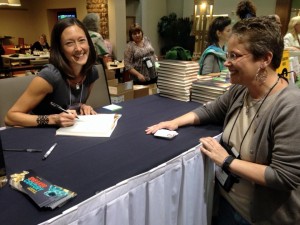 It was my delight to spend the weekend with book people extraordinaire, first at the Pacific NW Booksellers Association Trade Show and then at the Oregon Council of Teachers of English and Social Studies Conference. I was able to show off my book and meet some amazing people! My book stand also looked great. A book friend of mine recommended that I get a personalized banner stand from a company similar to Trade Show Booth to make my book stand out from the crowd and it certainly did! It got so much attention and I was able to share it with so many people.
It was my delight to spend the weekend with book people extraordinaire, first at the Pacific NW Booksellers Association Trade Show and then at the Oregon Council of Teachers of English and Social Studies Conference. I was able to show off my book and meet some amazing people! My book stand also looked great. A book friend of mine recommended that I get a personalized banner stand from a company similar to Trade Show Booth to make my book stand out from the crowd and it certainly did! It got so much attention and I was able to share it with so many people.
I did my first ever book signing for THE WAY BACK FROM BROKEN and was thrilled to have the first book go to Patti, an educator that I met several years ago during a school visit. 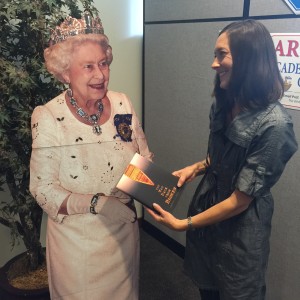
I had the distinct pleasure of exchanging books with Sheila Hamilton (ALL THE THINGS WE NEVER KNEW) and Ellen Urbani (LANDFALL).You are going to want to read these books!
I even gave the Queen a copy of my book. But you know what?
Hanging out with the book people was better! XO
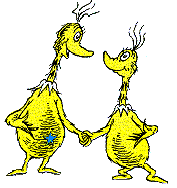 When I heard that THE WAY BACK FROM BROKEN was receiving a starred review from Booklist, I went a little crazy. As I shared the news with my family–I got a star! I got a star!–my son stopped me. “Wait a minute, mom. I thought one star was bad.”
When I heard that THE WAY BACK FROM BROKEN was receiving a starred review from Booklist, I went a little crazy. As I shared the news with my family–I got a star! I got a star!–my son stopped me. “Wait a minute, mom. I thought one star was bad.”
And thus we ended up discussing the meaning of stars.
Reviews are both torment and blessing for authors. The bad ones are a bitter pill even though we know (and appreciate) that not every book will appeal to every reader. The good ones are a better than espresso for motivating us to write more books. And, like it or not, reviews matter to sales.
The top reason people will buy a book is because it was recommended to them. Amazon reviews and Goodreads reviews (and their star rankings from 1-5) are the next level up from a personal recommendation. In this realm of reviews by readers, five stars are the magic elixir that raises our book from the depths, and a single star is what we give the neighbor’s dog when he goes poop in our yard.
Hence my son’s question.
The system with professional reviewers for trade industry outlets like School Library Journal, Kirkus Reviews, The Horn Book, and Booklist is a little different. Among these reviews, only a small fraction of the books reviewed are given a star. In fact, getting reviewed at all is considered an accomplishment. These reviews are important because libraries and bookstores use them to make decisions about what to buy.
Then there are the coveted New York Times and NPR reviews… Most authors never get covered by those outlets much less end up on any of their “best of the year” lists. Local media is more accessible and ultimately more useful to most of us.
It’s weird business, for sure.
We authors need the reviews (no matter the stars). So if you read a book you like (or don’t), post something on Amazon or Goodreads. Even a couple of sentences helps. And authors appreciate it!
As for me, I try not to fret too much about stars. There are plenty of fantastic books that never get the big industry reviews, and other spectacular reads that earn dog-poop-single-stars online. I also try to remember that…
… Sneetches are Sneetches
And no kind of Sneetch is the best on the beaches
That day, all the Sneetches forgot about stars
And whether they had one, or not, upon thars.
Thanks, Dr. Seuss. You’re the bomb!
Oh and if you were curious about that starred review from Booklist…
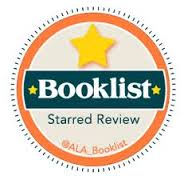 Keyser’s debut novel is an exquisite and enthralling exploration of loss, love, and healing. Rakmen, 15, is stuck going with his mother to what he calls the “dead baby club,” a support group both for parents who have lost their children and for surviving siblings. Rakmen’s baby sister, Dora, died in his arms, and he blames himself for not noticing that she was in distress until it was too late. The newest members are Mrs. Tatlas, his science teacher whose child was stillborn, and her 10-year-old daughter, Jacey, who is immediately drawn to Rakmen. Though he has an uneasy relationship with the girl, since any brotherly feelings he has for Jacey remind him of his dead sister, to his surprise, he finds himself traveling to Canada with Jacey and Mrs. Tatlas and embarking on a long-distance canoe trip, paddling and portaging through the wilderness. Whether Keyser is describing sensations, like holding a baby or riding the rapids in a canoe, or Rakmen’s palpable grief—“a sludgy wave of pain”—she does so with evocative language and a delicate touch. With a cast of diverse well-rounded characters, poignant relationships that never become schmaltzy, and a compelling high-stakes adventure, this vivid, moving exploration of grief and recovery hits all the right notes.
Keyser’s debut novel is an exquisite and enthralling exploration of loss, love, and healing. Rakmen, 15, is stuck going with his mother to what he calls the “dead baby club,” a support group both for parents who have lost their children and for surviving siblings. Rakmen’s baby sister, Dora, died in his arms, and he blames himself for not noticing that she was in distress until it was too late. The newest members are Mrs. Tatlas, his science teacher whose child was stillborn, and her 10-year-old daughter, Jacey, who is immediately drawn to Rakmen. Though he has an uneasy relationship with the girl, since any brotherly feelings he has for Jacey remind him of his dead sister, to his surprise, he finds himself traveling to Canada with Jacey and Mrs. Tatlas and embarking on a long-distance canoe trip, paddling and portaging through the wilderness. Whether Keyser is describing sensations, like holding a baby or riding the rapids in a canoe, or Rakmen’s palpable grief—“a sludgy wave of pain”—she does so with evocative language and a delicate touch. With a cast of diverse well-rounded characters, poignant relationships that never become schmaltzy, and a compelling high-stakes adventure, this vivid, moving exploration of grief and recovery hits all the right notes.
— Donna Scanlon
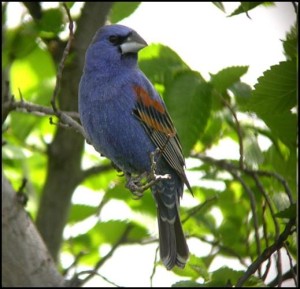 When I was working as an evolutionary biologist, I did a project on a wild population of birds called blue grosbeaks. In the spring, I set up nets, caught birds, took blood samples and measurements, gave them colored leg bands, and released them. The rest of the spring and summer was spent chasing them around cotton fields with binoculars.
When I was working as an evolutionary biologist, I did a project on a wild population of birds called blue grosbeaks. In the spring, I set up nets, caught birds, took blood samples and measurements, gave them colored leg bands, and released them. The rest of the spring and summer was spent chasing them around cotton fields with binoculars.
The team and I would spend hours making behavioral observations, identifying mated pairs, and finding nests. We set up tiny spy cameras to film the parents taking care of the young, and when the nestlings were old enough, we measured and banded them and took blood.
Like most scientific studies, we had multiple questions we hoped to address, but one in particular had to do with paternity. Was the male feeding the young at a nest actually their father? To answer that, I required blood samples from the male, the female and the nestlings.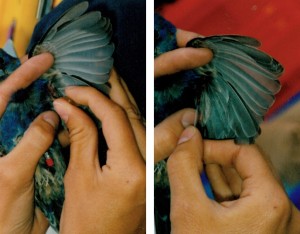
And also like any good scientific study, I needed numbers. No one wants to draw conclusions from skimpy data. We needed lots and lots of family groups to figure out the things we wanted to figure out.
Each complete set of blood samples in the lab freezer represented hours and hours of work in the field. Hours catching adults. Hours (more than you can imagine) searching for nests. Days waiting and hoping that the nestlings would survive long enough for us to collect blood samples.
Imagine me, bleary-eyed at four am, stumbling along the edge of the cotton field to check nests and finding one after another empty. Reviewing the video footage later, I would watch scruffy little half-feathered chicks disappear down the maw of a hungry snake. One day, I came to work to discover that the farmer had bush hogged the edges of the fields, unknowingly mowing down every single active nest in the area. Imagine me crying out of sheer frustration.
Uncertainty.
I am a planner, a goal-setter, a lister, a completer of tasks. I like the way step A leads to step B leads to step C leads to me checking the box—DONE.
BOOM!
I like knowing where I’ll be in a month, in a year. That’s not to say I don’t like change because I do, but I like it on my terms and well-channeled with lists.
But uncertainty is lurking around every corner, an ambush in the making. You may or may not find the nest at all. You never know when the bush hog is coming. And you’d be insane to think you could count on snakes.
Uncertainty.
I’m facing it head on, and it’s sure as hell making me squirm.
 I always leave writing conferences full of new ideas. Maybe a workshop has offered insight into some element of craft that I want to implement in my work in progress, or perhaps I’ve gleaned new strategies for social media and marketing.
I always leave writing conferences full of new ideas. Maybe a workshop has offered insight into some element of craft that I want to implement in my work in progress, or perhaps I’ve gleaned new strategies for social media and marketing.
I came home from the SCBWI-Western Washington Spring Conference with something a little different and probably far more valuable.
Sharon Flack and Nina Laden reminded me about intuition. Can I step back from over-analyzing and over-planning my projects and embrace the deep knowing of what my story needs?
Rachel Or asked us to trust in each other, in our art, and in ourselves.
David Wiesner spoke of faith in the ultimately unknowable act of creation that occurs when you commit to showing up on the page. Can I believe whole-heartedly in the process by which ideas are made manifest?
And to all this I will add kindness. A thousand thank yous to Dana Armin, Dana Sullivan, and Lily LaMotte for taking such good care of all of us this weekend. I was so happy to be among my people, to see your projects come to fruition, and to share my own. This writing business can be solitary and frustrating and heart-breaking, but it is also filled with the best people in the world.
And thus I begin work this morning full to brimming…
Intuition
Trust
Faith
Kindness
May they be yours as well.
 Hands down, it was The Voyage of the Dawn Treader by C. S. Lewis. I’ve probably read it thirty times. Oh, how I love Reepicheep! Close on the heels of this book comes My Side of the Mountain by Jean Craighead George. I always wanted my own Frightful.
Hands down, it was The Voyage of the Dawn Treader by C. S. Lewis. I’ve probably read it thirty times. Oh, how I love Reepicheep! Close on the heels of this book comes My Side of the Mountain by Jean Craighead George. I always wanted my own Frightful. What are the hardest/easiest parts of writing for you?
What are the hardest/easiest parts of writing for you? Sneaker Century and The Way Back from Broken are really different books. How do you manage to write both nonfiction and fiction?
Sneaker Century and The Way Back from Broken are really different books. How do you manage to write both nonfiction and fiction? Tell us something we don’t know about you!
Tell us something we don’t know about you! A few years ago I was teaching a workshop at a writing retreat. The event was sponsored by an organization that I care about, and I really wanted to do a good job. I prepared what I hoped would be whiz-bang-inspiring content that would give participants a toolbox for writing success. I practiced my talk. I got jazzed up and poured on the energy and enthusiasm during the presentation.
A few years ago I was teaching a workshop at a writing retreat. The event was sponsored by an organization that I care about, and I really wanted to do a good job. I prepared what I hoped would be whiz-bang-inspiring content that would give participants a toolbox for writing success. I practiced my talk. I got jazzed up and poured on the energy and enthusiasm during the presentation.
The talk went well. I could tell that the audience was engaged. I felt good about it…
… until about twenty minutes after I was done.
A fellow writer who I know professionally but not well came up to me and said, “You don’t have to try so hard. It won’t do any good.”
I went to my room and cried.
This month, I’ve been assailed on all sides—professional disappointments, family stressors, and an intense confrontation with someone whose criticisms cut to the very core of who I am as a person. But I try so hard, I lamented. I try to do my best work, to be my best self. I try and try and try.
And as I cried about all these new challenges, the words of my colleague, which I had found so deeply hurtful, returned: “You don’t have to try so hard. It won’t do any good.”
What I think she meant was this: no matter how hard I try there will still be people who don’t like the way I work, who don’t like my writing, and who don’t like me. The trying will not change their minds.
And thus, maybe it’s not about trying harder at all.
Or about working more.
Or being better.
Maybe I don’t have to try so hard because I am already enough.
As this year winds to a close, as we face a new year rising, this is what I want you to hear:
You—exactly as you are—you are enough.
And I love you.